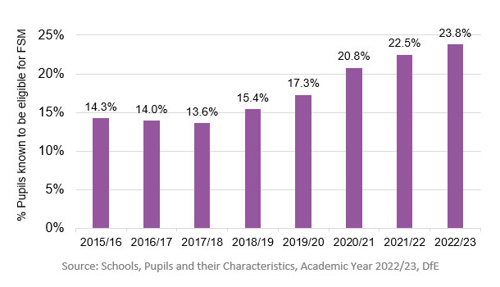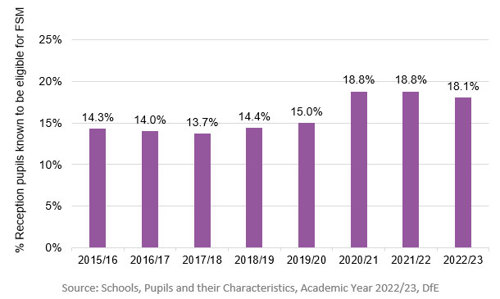Free school meal eligibility: What can the latest data really tell us?
Friday 9 June 2023
 Yesterday, the Department for Education (DfE) published new statistics showing over 2 million pupils, or 23.8 per cent of pupils in England, were eligible for free school meals (FSM) in January 2023. This is higher than last year.
Yesterday, the Department for Education (DfE) published new statistics showing over 2 million pupils, or 23.8 per cent of pupils in England, were eligible for free school meals (FSM) in January 2023. This is higher than last year.
It may be tempting to say this is the inevitable result of the current cost-of-living crisis, but this is not the whole story.
In this article, we show that, due to both transitional arrangements for Universal Credit and the freezing of income thresholds for FSM eligibility, the latest FSM eligibility data tells us very little about how disadvantage is changing in schools.
What is happening to pupil disadvantage?
Eligibility for free school meals is the main way in which disadvantage is identified within the English education system. It is used to target funding and identify disadvantaged pupils in schools. Figure 1 shows how FSM eligibility rates have changed each year. Last year, the rate was 22.5 per cent. This has now increased by 1.3 percentage points to 23.8 per cent.
However, this does not necessarily mean that more pupils are meeting the underlying criteria for being eligible for FSM in 2022/23.
Figure 1: Free School Meal Eligibility, 2015/16 - 2022/23

Impact of Universal Credit transitional arrangements
In 2018, the Government introduced transitional arrangements to smooth the roll out of Universal Credit. Previously, pupils who qualified for FSM would be deemed ineligible if their family circumstances improve. From April 2018 until the end whatever phase of education they are in as of March 2025, pupils will remain on FSM regardless of whether their family circumstances improve.
In other words, the transitional arrangements mean that pupils are eligible for FSM for longer. It is important to note that increases in FSM eligibility are largely among pupils who may already have been considered in need of additional support. Nevertheless, it means FSM rates will continue increasing, even if the number of children that meet the underlying criteria to qualify for FSM stays the same.
Therefore, yesterday’s headline increase in the FSM rate may simply be driven by the transitional arrangements. We can verify this by looking at how many pupils in Reception qualified for FSM each year, as Reception pupils are largely unaffected by the transitional arrangements. This is because they have only been in the school system for a short period of time.
Figure 2 shows that the percentage of FSM pupils in Reception fell from 18.8 per cent in 2021/22 to 18.1 per cent in 2022/23. This strongly suggests that the overall increase in the FSM rate is driven by the transitional arrangements.
Figure 2: Free School Meal Eligibility for Reception pupils, 2015/16 - 2022/23

However, families who are in need are missing out on FSM.
A family who receives Universal Credit must have a net income of £7,400 or less to be eligible for FSM. That income threshold has not changed since 2018/19, even though prices have increased significantly since then. The Institute for Fiscal Studies estimated that had the threshold kept pace with inflation, it would now be around £8,700. Freezing this threshold means that families and pupils who would have previously qualified and are likely to need additional support are now being excluded from FSM.
What are the implications?
Our analysis highlights that FSM eligibility rates cannot be used to understand how pupil disadvantage is changing over time.
This is a critical issue. Due to the changing profile of pupil disadvantage, our previous research has shown that it will become increasingly difficult to tell whether apparent changes to the disadvantaged attainment gap - which measures the difference in attainment between disadvantaged pupils and their peers – are being driven by changes to the composition of the disadvantaged group, economic conditions or genuine attainment progress.
To ensure that long-standing gaps between disadvantaged pupils and their peers are being adequately addressed, urgent action is needed by policymakers to establish a more meaningful set of measures for following the extent and effects of disadvantage in schools.
